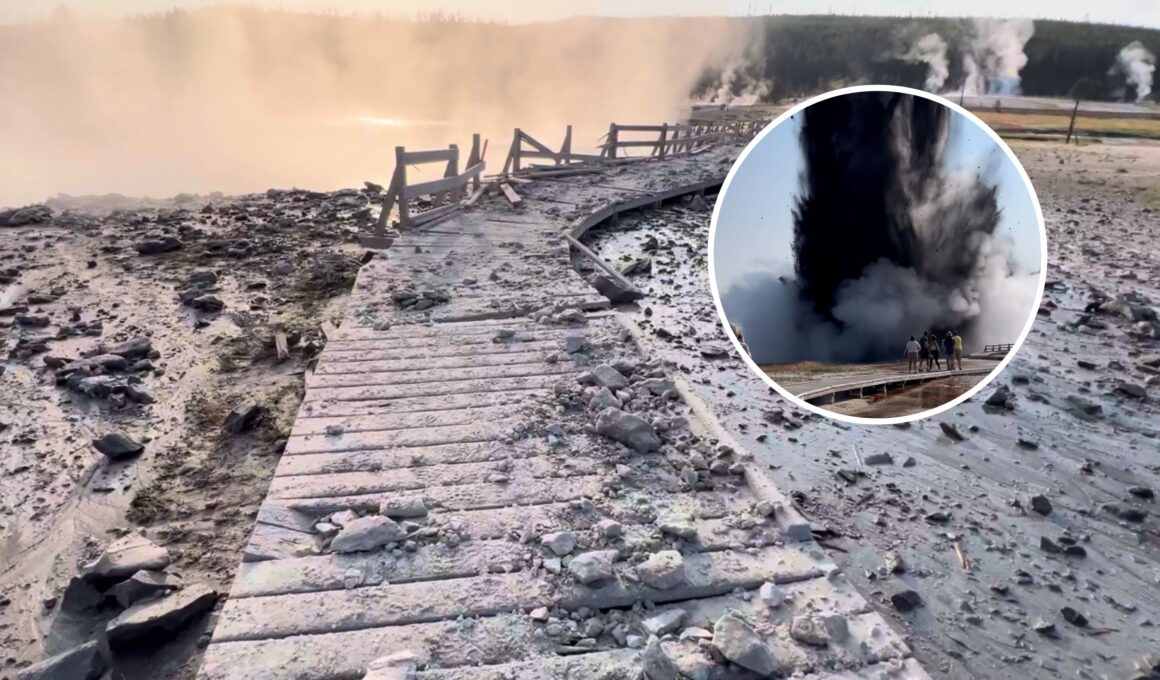Huge chunks of debris weighing hundreds of pounds and several feet across were flung into the air by the recent explosion in Yellowstone National Park.
A geyser in Yellowstone’s Biscuit Basin suddenly and violently exploded at about 10 a.m. local time on Tuesday because of a hydrothermal explosion underground, sending debris and boiling water and steam showering down on the area.
Some of these pieces of rock were up to 3 feet in diameter and weighed more than a person, according to an update from Yellowstone National Park and the United States Geological Survey.
“The explosion, which sent steam and debris to a height of hundreds of feet above the ground, destroyed a nearby boardwalk and ejected grapefruit-sized rocks tens to hundreds of feet from the source,” the statement said.
“Some blocks closest to the explosion site are about 3 feet (1 meter) wide and weigh hundreds of pounds. The explosion was largely directed to the northeast toward the Firehole River, and the largest blocks of debris fell in that direction,” the statement added.
The explosion was caught on camera by California real estate agent Vlada March, with the video showing a dark gray plume rapidly rising into the air, followed by a curtain of hot steam and rocks falling to the ground as tourists ran back along the boardwalk. No injuries were reported following the explosion.
“The dark color of the explosion was a result of mud and debris mixed with steam and boiling water,” the park said in the statement.
The explosion occurred near a feature named Black Diamond Pool, which changed shape after the explosion.
Aerial image shows location of this morning’s hydrothermal explosion in #Yellowstone‘s #BiscuitBasin. Light gray area shows how far mud & rocks were hurled. While explosion was near the boardwalk & visitors were present, no injuries were reported. NPS photo taken Jul 23, 2024. pic.twitter.com/O5T4YLUEiA
— USGS Volcanoes🌋 (@USGSVolcanoes) July 23, 2024
“The shape of Black Diamond has changed somewhat,” the national park said. “Just after the eruption, Black Diamond Pool exhibited minor roiling and water spouting. The water level in the pool rose over the course of the day, and by Tuesday afternoon the roiling transitioned to occasional bursts of hot water that reached about 8 feet (2.4 meters) in height.”
The levels of the Black Diamond Pool and nearby Black Opal Pool had risen so much by Wednesday morning that they were overflowing, leaking dark-colored water into the Firehole River.
Yellowstone is situated above a mantle plume or hot spot, where hot, buoyant magma rises from deep within the Earth. This is the driver behind the area’s geysers, hot springs and numerous other geothermal features.
The ejection is called a hydrothermal explosion, which is a fairly common occurrence in Yellowstone. Water below the ground is heated by the region’s geothermal energy, often becoming superheated—heated beyond its boiling point without turning into steam because of high pressure. If this superheated water becomes trapped by layers of rock, clay or other impermeable materials, pressure can build up significantly and is suddenly released in a giant explosion, sending hot water, steam and rock flying into the air.
The explosion had nothing to do with volcanic activity, thankfully.
“The July 23, 2024, hydrothermal explosion at Biscuit Basin resulted from water suddenly transitioning to steam in the shallow hydrothermal system beneath Black Diamond Pool and was not caused by volcanic activity,” the park said. “Seismicity, ground deformation, and gas and thermal emissions remain at their normal background levels, and there were no detectable precursors to this event.”
Yellowstone officials have closed Biscuit Basin to visitors for the remainder of the 2024 season in case another explosion is imminent and will monitor the area closely over the coming weeks.
“Given the recent changes to the hydrothermal plumbing system, small explosions of boiling water from this area in Biscuit Basin continue to be possible over the coming days to months,” the park said.
Do you have a tip on a science story that Newsweek should be covering? Do you have a question about Yellowstone? Let us know via science@newsweek.com.
Uncommon Knowledge
Newsweek is committed to challenging conventional wisdom and finding connections in the search for common ground.
Newsweek is committed to challenging conventional wisdom and finding connections in the search for common ground.






